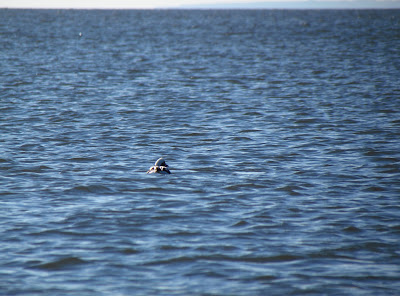 |
| brants |
I hoped that I might find the long-tailed ducks near the rocks at the point that forms the far end of the next bay up the coast. It is nearing a low tide and the last time that I saw them, it was a high tide. Some birds move around with the tides to get optimal feeding, so I did not have any reason to expect them. The wind was from the NW today at a brisk 10mph or so. That meant it was a somewhat offshore breeze and while I had to power into it, it did not create waves other than a skimming chop. But, even with a windchill that numbed my fingertips and stung my ears, it was sunny with a brilliant blue sky. At the rocky point, I found brants sitting on the rock ahead of me and to my left, watching me and waiting for me to get too close upon which they will fly to their next favorite feeding spot up the shore. In the gap between that point and a rock islet were four long-tailed ducks. They are a backward duck, wearing their best colors in winter and their drab colors in mating, just the opposite of other ducks. I aimed my camera (the only thing I aim anymore) at one and it dove. Long-tails are the deepest diving of all ducks. It was down an unlikely long time. I did not see the purple sandpipers this time. They had been on the edge of an islet on my last trip...it was a new bird to me and I hoped to see them again.
 |
| long-tailed duck |
I decided to continue to the mouth of the Oyster River, which is in the next bay. I had seen loons here on my last trip and I saw them once again on this one - one red-throated and a pair of common. The common loons thoughtfully identified themselves by calling. The closer that I got to the Oyster River, the stronger the wind. It funneled straight out of that low spot requiring firm paddling until the water became so shallow that I could not get a full paddle blade into the water. But, I now knew the lay of that river mouth and, like many of the small rivers here, it would always be a wade at low tide. I could turn back.
I returned on a downwind. The purple sandpipers, seven of them, were once again sitting on the seaward side of that islet as the wind blew me past.

No comments:
Post a Comment